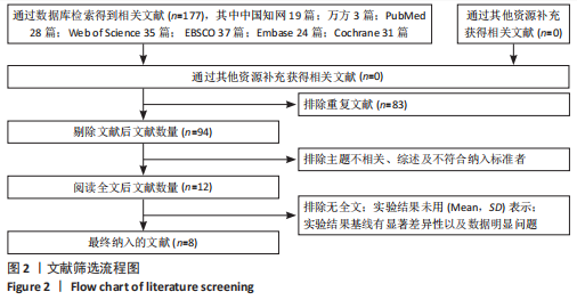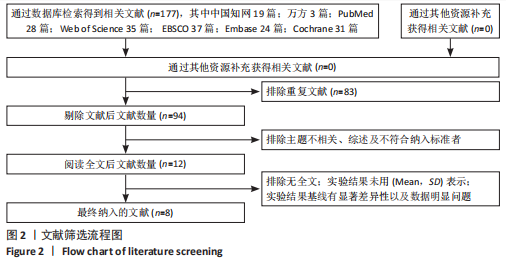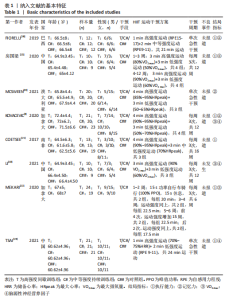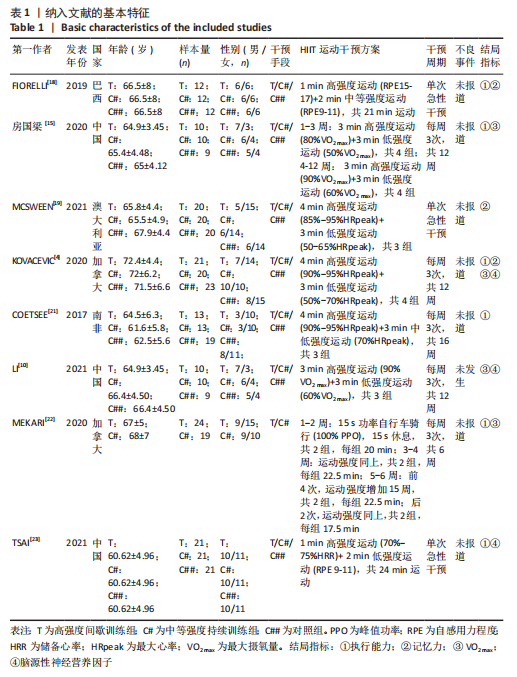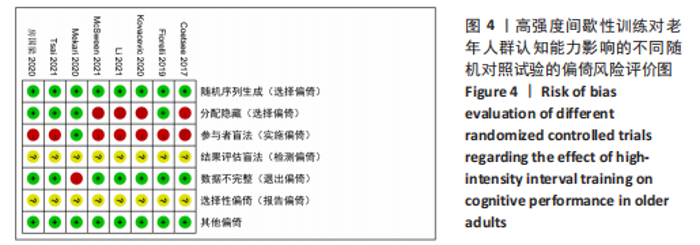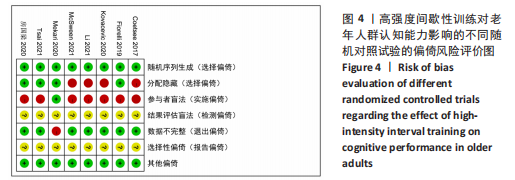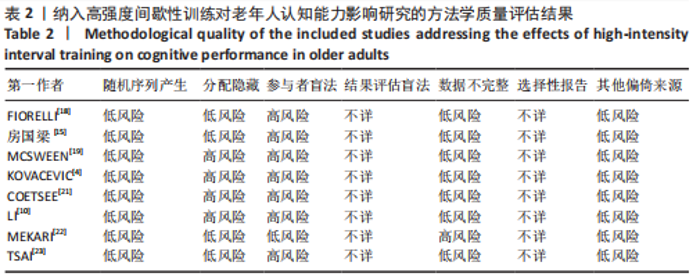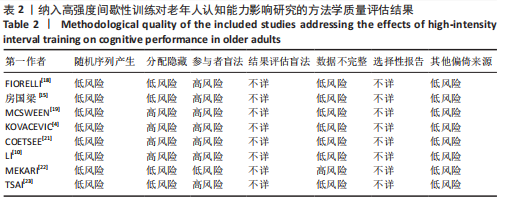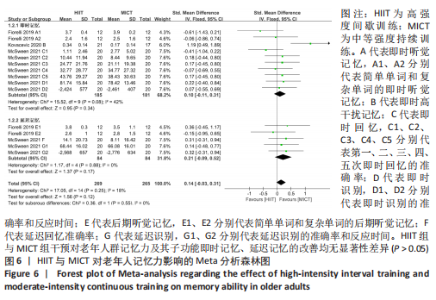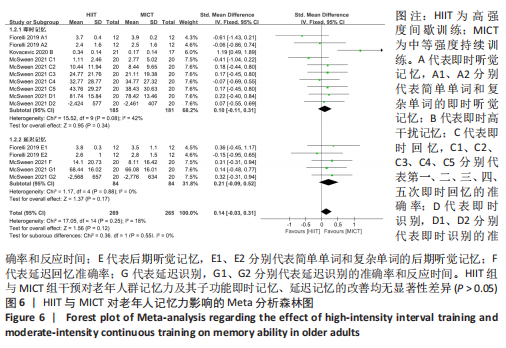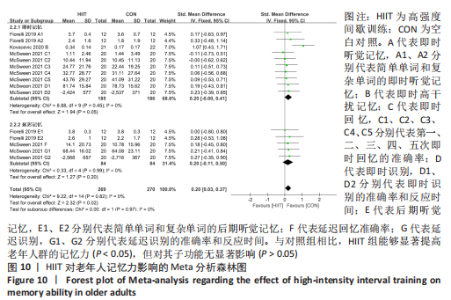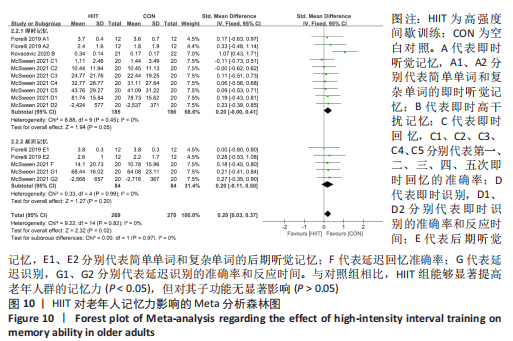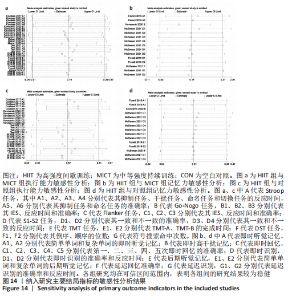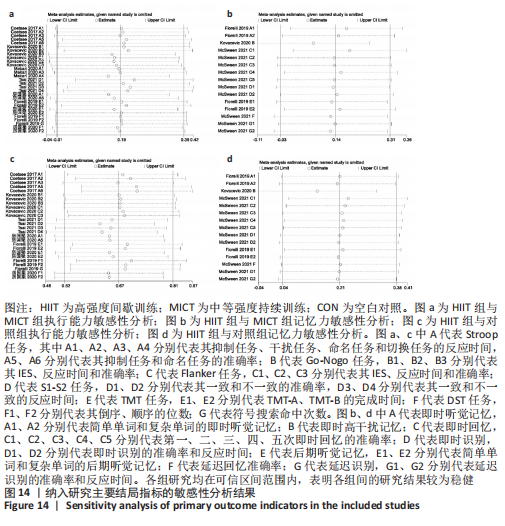Chinese Journal of Tissue Engineering Research ›› 2024, Vol. 28 ›› Issue (14): 2282-2289.doi: 10.12307/2024.235
Previous Articles Next Articles
Effects of high-intensity interval training with different intervention durations on cognitive function in older adults: a Meta-analysis
Liu Xinxin1, Geng Zhizhong2, Chen Jian1
- 1School of Sports Medicine, Wuhan Sports University, Wuhan 430079, Hubei Province, China; 2School of Health Sciences, Shanghai University of Sport, Shanghai 200438, China
-
Received:2023-02-11Accepted:2023-03-14Online:2024-05-18Published:2023-07-28 -
Contact:Chen Jian, MD, Associate professor, School of Sports Medicine, Wuhan Sports University, Wuhan 430079, Hubei Province, China -
About author:Liu Xinxin, Master candidate, School of Sports Medicine, Wuhan Sports University, Wuhan 430079, Hubei Province, China
CLC Number:
Cite this article
Liu Xinxin, Geng Zhizhong, Chen Jian. Effects of high-intensity interval training with different intervention durations on cognitive function in older adults: a Meta-analysis[J]. Chinese Journal of Tissue Engineering Research, 2024, 28(14): 2282-2289.
share this article
Add to citation manager EndNote|Reference Manager|ProCite|BibTeX|RefWorks
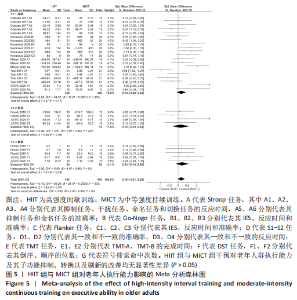
2.4 Meta分析结果 2.4.1 HIIT与MICT对老年人认知能力影响的Meta分析结果 (1)各组执行能力差异:文章对执行能力的Meta分析共纳入6篇文献。执行能力包括抑制、转换和刷新3个子功能,其中5篇文献研究了抑制功能[4,15,21-23],2篇文献研究了转换功能[15,18],2篇文献研究了刷新功能[15,18]。由于文章异质性较高(I2=53%),故采用随机效应模型分析。此外,由于各数据测量单位不同,故采用SMD值作为效应尺度指标。研究表明,与MICT组相比,HIIT在提高老年人的执行能力方面无显著性差异(SMD=0.18,95%CI:-0.01-0.38,P=0.07),见图5。"

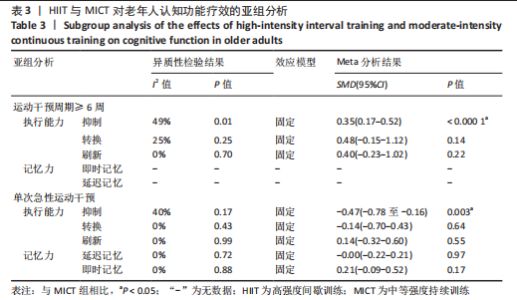
根据干预周期,对执行功能进行亚组分析,亚组分析后各研究间异质性较低,故采用固定效应模型分析,结果表明长期运动干预(干预周期≥6周),HIIT与MICT相比能够显著提高老年人的执行能力(SMD=0.36,95%CI:0.20-0.52,P < 0.000 1)和抑制能力(SMD=0.35,95%CI:0.17-0.52,P < 0.000 1)。但是在急性运动干预下,与HIIT相比,MICT能够有效提高老年人的执行能力(SMD=-0.25,95%CI:-0.49至-0.02,P=0.03)和抑制能力(SMD=-0.47,95%CI:-0.78至-0.16,P=0.003),其他子功能Meta分析结果详见表3。"
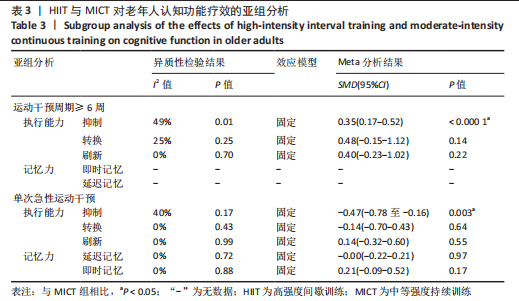
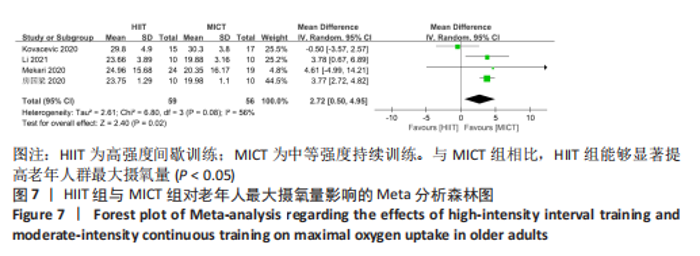
根据干预周期,对记忆力进行亚组分析,亚组分析后研究数据间无异质性(I2=0%),故采用固定效应模型分析,详见表3。结果表明急性运动干预下,HIIT与MICT相比对老年人记忆力的改善无显著性差异(SMD=0.07,95%CI:-0.11-0.24,P=0.44)。 (3)各组最大摄氧量变化:文章对VO2 max的Meta分析共纳入4篇文献[4,10,15,22]。由于文章异质性较高(I2=56%),故采用随机效应模型分析。此外,由于文章各数据测量单位相同,故采用WMD作为效应尺度指标。研究表明,HIIT比MICT能够有效提高老年人的VO2 max (WMD=2.72,95%CI:0.50-4.95,P=0.02),其他子功能Meta分析结果见图7。"
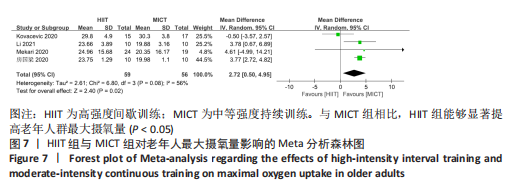
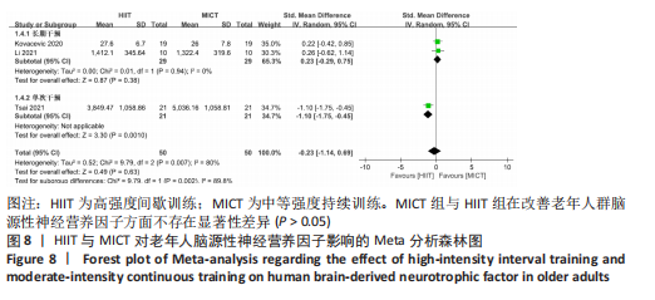
对VO2 max指标纳入的文献进行逐个数据剔除方法进行敏感性分析,结果发现剔除KOVACEVIC等[4]学者的研究后异质性发生改变(I2=0%),采用固定效应模型分析。结果仍表明,与MICT组相比,HIIT能够有效提高老年人的VO2 max (WMD=3.78,95%CI:2.79-4.77,P < 0.000 01)。 (4) 各组脑源性神经营养因子水平差异:文章对脑源性神经营养因子的Meta分析共纳入3篇文献[4,10,23]。由于文章异质性较高(I2=80%),故采用随机效应模型分析。由于各数据测量单位不同,故采用SMD作为效应尺度指标。与MICT组相比,HIIT对增加老年人的脑源性神经营养因子释放无显著性差异(SMD=-0.23,95%CI:-1.14-0.69,P=0.63)。通过亚组分析显示长期干预,两组仍无显著性差异(SMD=0.23,95%CI:-0.29-0.75,P=0.38),其他子功能Meta分析结果见图8。"
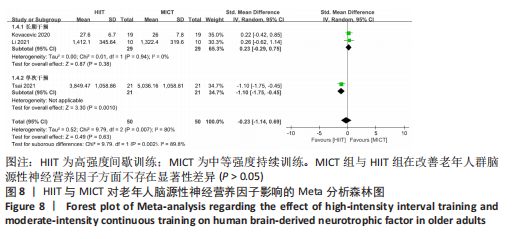
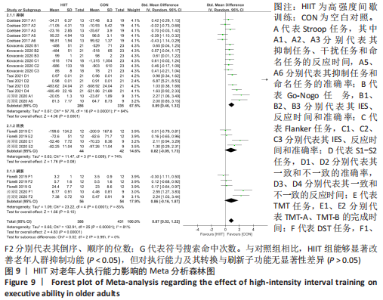
文章对脑源性神经营养因子指标纳入文献采用逐个数据剔除方法进行敏感性分析,研究异质性未发生改变,结果表明脑源性神经营养因子的Meta分析结果较为稳健。 2.4.2 HIIT与对老年人认知能力影响的Meta分析结果 (1)各组执行功能的差异:文章对执行能力的Meta分析共纳入5篇文献。其中4篇文献研究了抑制功能[4,15,21,23],2篇文献研究转换功能[15,18],2篇文献研究刷新功能[15,18]。由于文章异质性较高(I2=81%),故采用随机效应模型分析。由于各数据测量单位不同,故采用SMD作为效应尺度指标。结果表明,HIIT组与对照组相比能够有效提高老年人的执行能力(SMD=0.87,95%CI:0.52-1.22,P < 0.000 01)和抑制能力(SMD=0.89,95%CI:0.46-1.33,P < 0.000 1),其他子功能Meta分析结果见图9。"
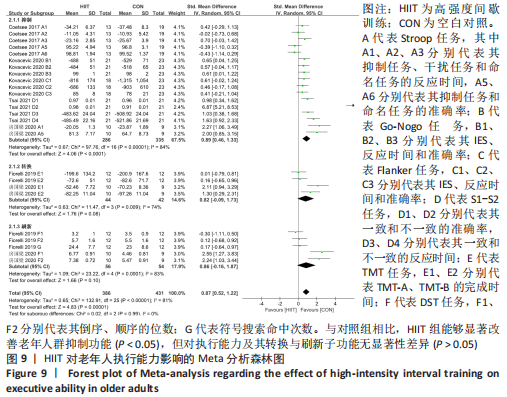
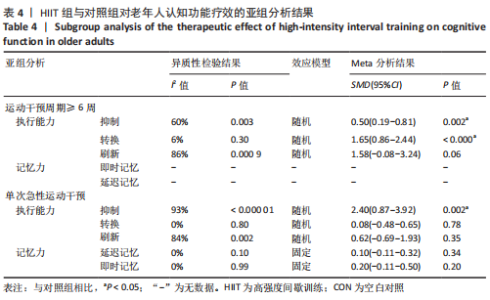
根据干预周期,对执行功能进行亚组分析,亚组分析后各研究间异质性较高,故采用随机效应模型分析,其他子功能Meta分析结果详见表4。结果表明,长期运动干预(干预周期≥6周)下,HIIT与对照组相比能够有效提高老年人的执行能力(SMD=0.75,95%CI:0.41-1.09,P < 0.000 1)、抑制能力(SMD=0.50,95%CI:0.19-0.81,P=0.002)以及转换能力(SMD=1.65,95%CI:0.86-2.44,P < 0.000 1)。同时急性运动干预下,与对照组相比,HIIT能够有效提高老年人的执行能力(SMD=1.25,95%CI:0.39-2.11,P=0.004)和抑制能力(SMD=2.40,95%CI:0.87-3.92,P=0.002)。"
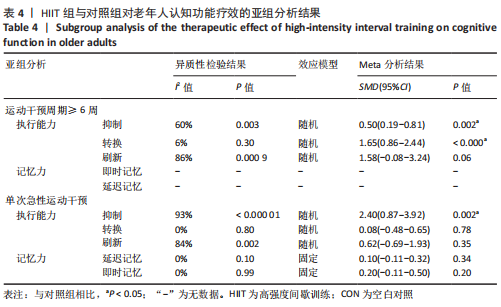

根据干预周期,对记忆力进行亚组分析,亚组分析后各研究间无异质性(I2=0%),故采用固定效应模型分析,详见表4。结果表明,急性运动干预下,HIIT与对照组相比,对老年人记忆力的改善无显著性差异(SMD=0.14,95%CI:-0.04-0.31,P=0.13)。 (3)各组最大摄氧量变化:文章对VO2 max的Meta分析共纳入3篇文献[4,10,15]。由于文章异质性较高(I2=69%),故采用随机效应模型分析。此外,由于文章各数据测量单位相同,故采用WMD作为效应尺度指标。研究表明,HIIT比CON能显著提高老年人的VO2 max(WMD=6.75,95%CI:4.20-9.29,P < 0.000 01),其他子功能Meta分析结果见图11。"

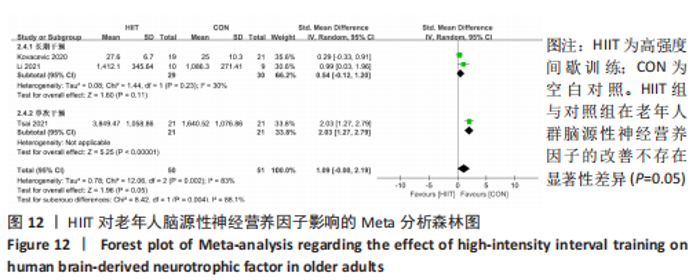
对VO2 max指标纳入的文献进行逐个数据剔除方法进行敏感性分析,结果发现剔除KOVACEVIC等[4]学者的研究后异质性发生改变(I2=0%),采用固定效应模型分析。结果仍表明,与对照组相比,HIIT能够有效提高老年人的VO2 max (WMD=5.58,95%CI:4.70-6.47,P < 0.000 01)。 (4)各组脑源性神经营养因子水平的差异:文章对脑源性神经营养因子的Meta分析共纳入3篇文献[4,10,23]。由于文章异质性较高(I2=83%),故采用随机效应模型分析。由于文章各数据测量单位不同,故采用SMD值作为效应尺度指标。与对照组相比,HIIT对增加老年人脑源性神经营养因子的释放无显著性差异(SMD=1.09,95%CI:-0.00-2.19,P=0.05)。通过亚组分析显示长期干预,两组脑源性神经因子水平仍无显著性差异(SMD=0.54,95%CI:-0.12-1.20,P=0.11),见图12。"
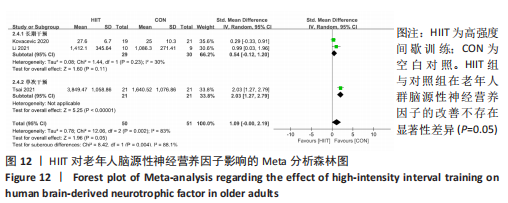
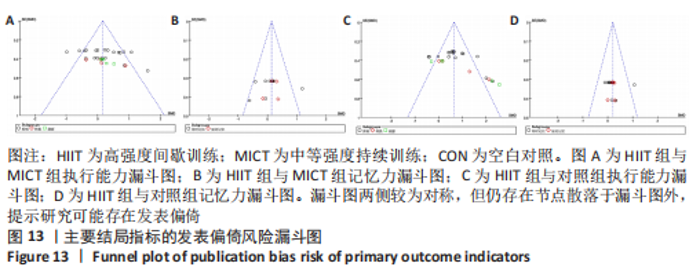
对脑源性神经营养因子指标纳入文献采用逐个数据剔除方法进行敏感性分析,研究异质性未发生改变,结果表明脑源性神经营养因子 Meta分析结果较为稳健。 2.5 发表偏倚分析结果 因文章中包含VO2 max以及脑源性神经营养因子指标纳入文献较少,故仅对包含执行能力以及记忆力指标的纳入研究进行漏斗图评估潜在发表偏倚。结果发现漏斗图较为对称,但仍存在节点散落于漏斗图外,表明研究可能存在发表偏倚,见图13。通过Egger法与Begg法结果显示,HIIT组与MICT组执行能力Egger检验z=1.89,P=0.058,Begg检验t=-1.36,P=0.184,均无显著性意义(P > 0.05);HIIT组与MICT组记忆力Egger检验z=0.59,P=0.553,Begg检验t=0.70,P=0.495,均无显著性意义(P > 0.05);HIIT组与对照组执行能力Egger检验z=0.04,P=0.659,Begg检验t=-1.15,P=0.261,均无显著性意义(P > 0.05);HIIT组与对照组记忆力Egger检验z=3.17,P=0.002,Begg检验t=0.04,P=0.965,当Egger与Begg检验结果不一致时以Egger检验结果为准[24],表明均无显著性意义(P > 0.05)。这与视觉观察判断结果不一致,则以统计学检验结果为准,提示文章各组内不存在发表偏倚。"
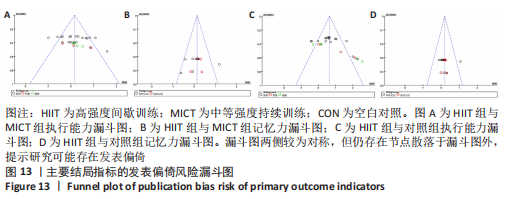
| [1] 杨涵墨.中国人口老龄化新趋势及老年人口新特征[J].人口研究,2022,46(5):104-116. [2] WARD A, ARRIGHI HM, MICHELS S, et al. Mild cognitive impairment: disparity of incidence and prevalence estimates. Alzheimers Dement. 2012,8(1):14-21. [3] LINDBERGH CA, DISHMAN RK, MILLER LS. Functional disability in mild cognitive impairment: a systematic review and meta-analysis. Neuropsychol Rev. 2016;26(2):129-159. [4] KOVACEVIC A, FENESI B, PAOLUCCI E, et al. The effects of aerobic exercise intensity on memory in older adults. Appl Physiol Nutr Metab. 2020; 45(6):591-600. [5] PETERSEN RC, DOODY R, KURZ A, et al. Current concepts in mild cognitive impairment. Arch Neurol. 2001;58(12):1985-1992. [6] CLARK LR, SCHIEHSER DM, WEISSBERGER GH, et al. Specific measures of executive function predict cognitive decline in older adults. J Int Neuropsychol Soc. 2012;18(1):118-127. [7] WINBLAD B, AMOUYEL P, ANDRIEU S, et al. Defeating Alzheimer’s disease and other dementias: a priority for European science and society. Lancet Neurol. 2016;15(5):455-532. [8] LUPPA M, LUCK T, WEYERER S, et al. Prediction of institutionalization in the elderly. A systematic review. Age Ageing. 2010;39(1):31-38. [9] COLCOMBE SJ, ERICKSON KI, SCALF PE, et al. Aerobic exercise training increases brain volume in aging humans. J Gerontol A Biol Sci Med Sci. 2006;61(11):1166-1170. [10] LI X, HAN T, ZOU X, et al. Long-term high-intensity interval training increases serum neurotrophic factors in elderly overweight and obese Chinese adults. Eur J Appl Physiol. 2021;121(10): 2773-2785. [11] GUINEY H, MACHADO L. Benefits of regular aerobic exercise for executive functioning in healthy populations. Psychon Bull Rev. 2013;20(1): 73-86. [12] ANGEVAREN M, VANHEES L, WENDELVOS W, et al. Intensity, but not duration, of physical activities is related to cognitive function. Eur J Cardiovasc Prev Rehabil. 2007;14(6):825-830. [13] BURGOMASTER KA, HOWARTH KR, PHILLIPS SM, et al. Similar metabolic adaptations during exercise after low volume sprint interval and traditional endurance training in humans. J Physiol. 2008;586(1):151-160. [14] 刘建秀,方雯,王帝之,等.高强度间歇训练促进儿童青少年健康:现状·机制·可行性[J]. 体育科学,2019,39(8):61-72. [15] 房国梁,张漓,韩天雨,等.高强度间歇训练对老年人认知功能的影响[J]. 中国体育科技, 2020,56(11):32-37. [16] 胡静芸,蔡明,商庆慧,等.高强度间歇训练改善认知功能及其机制研究进展[J]. 生理学报, 2021,73(1):126-136. [17] ANGEVAREN M, AUFDEMKAMPE G, VERHAAR HJ, et al. Physical activity and enhanced fitness to improve cognitive function in older people without known cognitive impairment. Cochrane Database Syst Rev. 2008;16(3):CD005381. [18] FIORELLI CM, CIOLAC EG, SIMIELI L, et al. Differential acute effect of high-intensity interval or continuous moderate exercise on cognition in individuals with Parkinson’s disease. J Phys Act Health. 2019;16(2):157-164. [19] MCSWEEN MP, MCMAHON KL, MAGUIRE K, et al. The acute effects of different exercise intensities on associative novel word learning in healthy older adults: a randomized controlled trial. J Aging Phys Act. 2021;29(5):793-806. [20] 谷鸿秋,王杨,李卫.Cochrane偏倚风险评估工具在随机对照研究Meta分析中的应用[J]. 中国循环杂志,2014,29(2):147-148. [21] COETSEE C, TERBLANCHE E. The effect of three different exercise training modalities on cognitive and physical function in a healthy older population. Eur Rev Aging Phys Act. 2017;14:13. [22] MEKARI S, NEYEDLI HF, FRASER S, et al. High-intensity interval training improves cognitive flexibility in older adults. Brain Sci. 2020;10(11): 796. [23] TSAI CL, PAN CY, TSENG YT, et al. Acute effects of high-intensity interval training and moderate-intensity continuous exercise on BDNF and irisin levels and neurocognitive performance in late middle-aged and older adults. Behav Brain Res. 2021;413:113472. [24] 石修权,王增珍.Egger’s test与Begg’s test的功效差异比较与原因分析[J].华中科技大学学报(医学版),2009,38(1):91-93. [25] FREDERIKSEN KS, VERDELHO A, MADUREIRA S, et al. Physical activity in the elderly is associated with improved executive function and processing speed: the LADIS Study. Int J Geriatr Psychiatry. 2015, 30(7):744-750. [26] DUSTMAN RE, RUHLING RO, RUSSELL EM, et al. Aerobic exercise training and improved neuropsychological function of older individuals. Neurobiol Aging, 1984;5(1):35-42. [27] SMILEY-OYEN AL, LOWRY KA, FRANCOIS SJ, et al. Exercise, fitness, and neurocognitive function in older adults: the “selective improvement” and “cardiovascular fitness” hypotheses. Ann Behav Med. 2008;36(3):280-291. [28] HELGERUD J, HøYDAL K, WANG E, et al. Aerobic high-intensity intervals improve VO2max more than moderate training. Med Sci Sports Exerc. 2007;39(4):665-6671. [29] PREDOVAN D, FRASER SA, RENAUD M, et al. The effect of three months of aerobic training on stroop performance in older adults. J Aging Res. 2012. doi: 10.1155/2012/269815. [30] AI JY, CHEN FT, HSIEH SS, et al. The effect of acute high-intensity interval training on executive function: a systematic review. Int J Environ Res Public Health. 2021;18(7):3593. [31] DIAMOND A. Executive functions. Annu Rev Psychol. 2013;64:135-168. [32] 陈天勇,韩布新,罗跃嘉,等.认知年老化与执行衰退假说[J].心理科学进展,2004(5): 729-736. [33] ERICKSON K, KRAMER AF. Aerobic exercise effects on cognitive and neural plasticity in older adults. Br J Sports Med. 2009;43(1):22-24. [34] 金晶. 身体活动影响老年人执行功能的行为与脑特征[D].上海:上海体育学院,2021. [35] ERICKSON K, VOSS M, PRAKASH R, et al. Exercise training improves size of hippocampus and improves memory. Proc Natl Acad Sci U S A. 2011; 108(7):3017-3022. [36] FJELL AM, MCEVOY L, HOLLAND D, et al. What is normal in normal aging? Effects of aging, amyloid and Alzheimer’s disease on the cerebral cortex and the hippocampus. Prog Neurobiol. 2014; 117:20-40. [37] BHERER L, ERICKSON KI, LIU-AMBROSE T. Physical exercise and brain functions in older adults. J Aging Res. 2013. doi: 10.1155/2013/197326. [38] ANDRIANOPOULOS V, GLOECKL R, VOGIATZIS I, et al. Cognitive impairment in COPD: should cognitive evaluation be part of respiratory assessment? Breathe (Sheff). 2017;13(1):e1-e9. [39] COLCOMBE S, KRAMER AF. Fitness effects on the cognitive function of older adults: a meta-analytic study. Psychol Sci. 2003;14(2):125-130. [40] KRAMER AF, HAHN S, COHEN NJ, et al. Ageing, fitness and neurocognitive function. Nature. 1999;400(6743):418-419. [41] MCAULEY E, KRAMER AF, COLCOMBE SJ. Cardiovascular fitness and neurocognitive function in older adults: a brief review. Brain Behav Immun. 2004;18(3):214-220. [42] CASSILHAS RC, VIANA VA, GRASSMANN V, et al. The impact of resistance exercise on the cognitive function of the elderly. Med Sci Sports Exerc. 2007;39(8):1401-407. [43] SEIFERT T, BRASSARD P, WISSENBERG M, et al. Endurance training enhances BDNF release from the human brain. Am J Physiol Regul Integr Comp Physiol. 2010;298(2):R372-R377. |
| [1] | Zhang Yuxin, Yu Cong, Zhang Cui, Ding Jianjun, Chen Yan. Differences in postural control ability between older adults with mild cognitive impairment and those with normal cognition under different single-task and dual-task conditions [J]. Chinese Journal of Tissue Engineering Research, 2025, 29(8): 1643-1649. |
| [2] | Wang Qiuyue, Jin Pan, Pu Rui . Exercise intervention and the role of pyroptosis in osteoarthritis [J]. Chinese Journal of Tissue Engineering Research, 2025, 29(8): 1667-1675. |
| [3] | Wang Yida, Liu Jun, Wang Xiaoling, Wang Liyan, Yang Chengru, Zhang Xuexiao. Effects of wearable electronic device-based interventions on physical activity and sedentary behavior in healthy adolescents: a meta-analysis [J]. Chinese Journal of Tissue Engineering Research, 2025, 29(8): 1693-1704. |
| [4] | Zhang Zixian, Xu Youliang, Wu Shaokui, Wang Xiangying. Effects of blood flow restriction training combined with resistance training on muscle indicators in college athletes: a meta-analysis [J]. Chinese Journal of Tissue Engineering Research, 2025, 29(8): 1705-1713. |
| [5] | Wang Juan, Wang Guanglan, Zuo Huiwu. Efficacy of exercise therapy in the treatment of anterior cruciate ligament reconstruction patients: #br# a network meta-analysis #br# [J]. Chinese Journal of Tissue Engineering Research, 2025, 29(8): 1714-1726. |
| [6] | Zheng Huakun, Yin Mingyue, Liu Qian. Effects of interval and continuous training on the quality of life in physically inactive adults: a meta-analysis [J]. Chinese Journal of Tissue Engineering Research, 2025, 29(8): 1727-1740. |
| [7] | Lou Guo, Zhang Min, Fu Changxi. Exercise preconditioning for eight weeks enhances therapeutic effect of adipose-derived stem cells in rats with myocardial infarction [J]. Chinese Journal of Tissue Engineering Research, 2025, 29(7): 1363-1370. |
| [8] | Ma Haoyu, Qiao Hongchao, Hao Qianqian, Shi Dongbo. Causal effects of different exercise intensities on the risk of osteoarthritis [J]. Chinese Journal of Tissue Engineering Research, 2025, 29(6): 1305-1311. |
| [9] | Zhang Shuai, Li Zichun, Xu Yihao, Xie Xiaofeng, Guo Zhongsheng, Zhao Qingyang. Effect of transcranial magneto-acousto-electrical stimulation on the plasticity of the prefrontal cortex network in mice [J]. Chinese Journal of Tissue Engineering Research, 2025, 29(6): 1108-1117. |
| [10] | Zheng Rongfa, Mo Weibin, Huang Peng, Chen Junji, Liang Ting, Zi Fangyu, Li Guofeng. Effects of electroacupuncture on the expression of metabolic enzymes and autophagy genes in gastrocnemius muscle tissues of exercising rats [J]. Chinese Journal of Tissue Engineering Research, 2025, 29(6): 1127-1136. |
| [11] | Chen Yuning, Jiang Ying, Liao Xiangyu, Chen Qiongjun, Xiong Liang, Liu Yue, Liu Tong. Buqi Huoxue Compounds intervene with the expression of related factors and autophagy related proteins in a rat model of cerebral ischemia/reperfusion [J]. Chinese Journal of Tissue Engineering Research, 2025, 29(6): 1152-1158. |
| [12] | Zhao Xiaoxuan, Liu Shuaiyi, Li Qi, Xing Zheng, Li Qingwen, Chu Xiaolei. Different exercise modalities promote functional recovery after peripheral nerve injury [J]. Chinese Journal of Tissue Engineering Research, 2025, 29(6): 1248-1256. |
| [13] | Zhang Wenhua, Li Xun, Zhang Weichao, Li Xinying, Ma Guoao, Wang Xiaoqiang . Promoting myogenesis based on the SphK1/S1P/S1PR2 signaling pathway: a new perspective on improving skeletal muscle health through exercise [J]. Chinese Journal of Tissue Engineering Research, 2025, 29(6): 1265-1275. |
| [14] | Wang Dongyang, Yang Qiaohui, Lin Xinchao. Relationship between vitamin D levels and reproductive characteristics and exercise dietary situation in postmenopausal women [J]. Chinese Journal of Tissue Engineering Research, 2025, 29(5): 1021-1025. |
| [15] | Li Huijun, Li Huangyan, Zhang Yeting. Physical activity and cognition in older adults: research hotspot and topic evolution [J]. Chinese Journal of Tissue Engineering Research, 2025, 29(5): 1073-1080. |
| Viewed | ||||||
|
Full text |
|
|||||
|
Abstract |
|
|||||
